Published
on 29
May 2016
|
All rights reserved.
|
|
718 Boxster
|
|
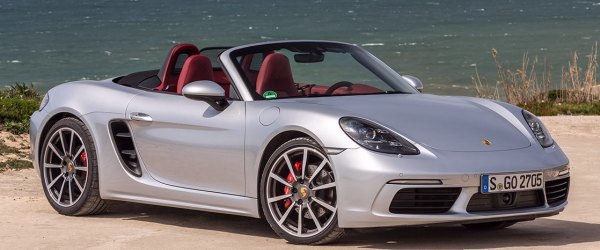
|
|
Porsche
finally corrects its wrongs with the new 718, but by doing so it
introduces another wrong...
|
|
Time flies. The original Boxster was born exactly
20 years ago. People said it saved Porsche from bankruptcy and laid the
foundation for the company’s rebound. It was also the first Porsche to
break the tradition of triple-digit model numbers. Since then, you get
Cayenne, Cayman,
Panamera and Macan. To me, these names sound silly
rather than romantic. I would rather have the good old numeric
codenames, because they are not only more relevant to tradition but
also give
you a sense of progress, such as from 924 to 944 to 968. If you talk
about “Boxster”, pardon, which one? In the end, you still need the
internal codenames 986, 987 and 981 to distinguish different
iterations. Only non-enthusiasts would prefer the marketing names.
Another confusing thing about the old car was its relationship with
Cayman. You know, both cars were practically the same except the roof,
but Porsche marketed them as separate models and, even more
confusingly, positioned the hardtop coupe higher on the price list than
the soft top, which is the contrary to common sense – see what if
Volkswagen priced the Golf hatchback higher than Golf Cabriolet. To
justify the higher prices, it had to claim slightly more power for all
Cayman models, even though we know their engines were practically the
same
as Boxster’s.
So we are glad to see Porsche finally corrects its wrongs with the new
718 Boxster and Cayman. Now the 718 name sits rationally below 911
(although its internal codename is actually 982),
while the Boxster and Cayman labels are relegated to represent the
different roofs. Everything else between Boxster and Cayman is exactly
the same, no matter power, performance figures or even kerb weight (see
spec. table below). And the roadster finally charges more than the
coupe, although the gap is small.

|
|
Wendelin
Wiedeking decided to equip the original Boxster with flat-six just
because he had a tight budget...
|
|
This is actually the second 718 created by Porsche. The first was a
flyweight
race car built between 1957 and 1962 as the successor of 550 Spyder. It
was good-looking. It had racing glories – 3 Targa Florio laurels and a
Sebring 12 hours trophy. But most important to Porsche, it shared a
common
feature with the new 718 Boxster and Cayman: a four-cylinder boxer
engine. And that is also what separates it from the flat-six-powered
981 / 987 / 986. The relegation from 6 to 4-cylinder might raise some
eyebrows, but to me it seems to be a rational movement to add
further breathing space to the 911. In fact, traditionally the
smaller Porsches (924, 944 and 968, also the majority of 914) were
powered by 4-cylinder engines to keep cost down. Wendelin Wiedeking
decided to equip the original Boxster with flat-six just because
he had a tight budget to develop both the Boxster and 996.
From this perspective, the reversion to 4-cylinder engine is also a
correction.
It goes without saying the downsized engine is supplemented with
turbocharging, so it actually gets more power (and even more torque),
higher performance yet drinks less fuel, just as you would expect for a
“modern” engine. Unsurprisingly, this flat-4 shares many basic design
features with the 3.0-liter turbocharged flat-six of new 911 Carrera
and Carrera S so that about 40 percent parts are shared. Like the
latter, it has a 118 mm bore center. The version employed by the base
Boxster and Cayman displaces 1988 c.c., employs the same 91 mm bore and
76.4 mm stroke so that you might see it as the cut-down version of
the 911 engine (no, it is not, as you will see the differences later).
The more powerful Boxster S and Cayman S engine has its
bore enlarged to 102 mm while keeping the short stroke unchanged, so
the combustion chambers are very oversquared. Its capacity is increased
to 2497 c.c. Sounds like a 944 Turbo engine. The big flat-four needs no
balance shafts, of course.
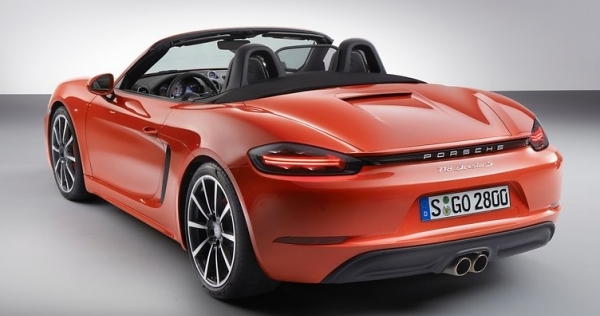
|
|
The
flat-4 shares many basic design features with flat-six of 911 so that
40 percent parts are shared.
|
|
If it was not a horizontally-opposed engine, you might think the base
2.0-liter turbo comes from Volkswagen Golf R (after all, Macan employs
mostly Volkswagen and Audi engines), since it offers identical power
and torque: 300 horsepower and 280 pound-foot. Yes, the Porsche
flat-four is no superior to VW’s inline-four! Nor its delivery more
flexible. Its maximum torque is delivered from 1950 to 4500 rpm,
completely overshadowed by the Volkswagen’s 1800-5500 rpm. The only
thing to applause is its 7500 rpm redline, which is quite high for a
turbocharged motor, but then you are unlikely to visit it often, since
peak power arrives at 6500 rpm.
The same can be said to the 2.5-liter version. It produces 350
horsepower at 6500 rpm and 310 pound-foot from 1900 to 4500 rpm. Its
specific power is actually lower than the 2.0-liter unit because it
employs lower turbo boost pressure, i.e. 1.1 bar instead of the smaller
engine’s 1.4 bar. For sure it leaves enough space for the future GTS or
GT4 derivatives. Both new motors enjoy a 35 horsepower boost from the
old car’s 2.7- and 3.4-liter flat-six, while their torque deliveries
are massively stronger, especially at lower revs. Meanwhile, their EU
fuel consumption is reduced by 13 and 11 percent respectively, now
averaging 40.9 mpg and 38.6 mpg.
Thanks to the new engines, the base 718 duo tops 171 mph, an increase
of 7 mph. Moreover, with PDK gearbox and sports chrono pack (launch
control) selected, 0-60 mph acceleration is slashed from the old car's
5.2
seconds to 4.5 seconds, i.e. a night and day difference! Meanwhile, 718
S can sprint from rest to 60 mph in 4.0 seconds, down six-tenths, and
flat out at 177 mph. In Nurburgring Nordschleife, the 718 Boxster S
managed a best lap time of 7 min 42 sec, 16 seconds faster than the old
car and only 2 seconds behind the outgoing Cayman GT4, although the new
turbocharged 911 Carrera S is still comfortably ahead at 7 min 30 sec.
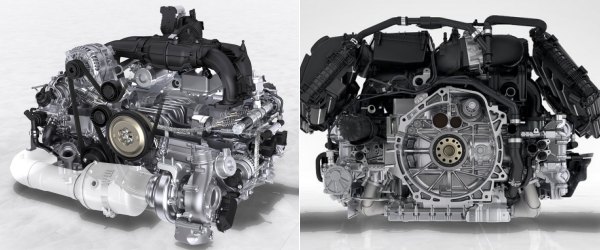
|
|
The
Porsche flat-four is no superior to VW’s inline-four!
|
|
From engineering point of view, the flat-four turbo is not as perfect
as the 911’s flat-six turbo. While the 911 engine employs a pair of
small turbos, one for each bank in a straightforward layout, the
flat-four employs a single turbocharger located at the front of the
engine, practically taking the space left by the deleted cylinders. Why
not twin-turbo? Because the firing order of flat-four is 1-3-2-4, which
means the 2 cylinders in each bank fire in succession, then rest for
some time and fire in succession again. If they were connected to the
same turbo, the uneven exhaust pulse train would seriously reduce the
efficiency of turbo. The only solution is to connect all 4 cylinders to
a single turbo, then it will get evenly spaced exhaust pulses, one
every 180 degrees of crank revolution. Alternatively, you can connect
cylinder 1-2 to a turbo and 3-4 to another turbo, but that would
require cumbersome piping, which is a nightmare to packaging as well as
cooling. Moreover, whether the 2 or 2.5-liter displacement can feed 2
turbos with enough gas is questionable. Therefore, Porsche opted for
the single-turbo solution.
However, collecting all exhaust gas from both banks of cylinder to a
single turbo requires long exhaust manifolds running under the engine
sump (the exhaust ports located at the underside). This also needs
extra care to shield the heat from the lubrication system. More
worrying, the longer exhaust manifolds result in more turbo lag.
Moreover, the fresh air pumped out from the single turbo also needs
longer pipes to reach the cylinders, which causes further turbo lag and
delay of throttle response. Therefore, the flat-four turbo is not going
to be as responsive as the 911’s flat-six twin-turbo. Neither can it
match the straight-4 turbo engines commonly found on the market,
unfortunately. This explains the aformentioned comparison with Golf R
engine. In fact, the only other engine with a similar layout, Subaru's
flat-4 turbo, is also notorious for turbo lag.
So why does Porsche opt for flat-4 instead of inline-4? Flat-4 enables
the 718 to have lower center of gravity as well as an inherently
smoother operation hence the higher (7500 rpm) redline. But for the
most part, I would say because of tradition and image reasons. Just
like a 911 will always keep its engine at the wrong side.
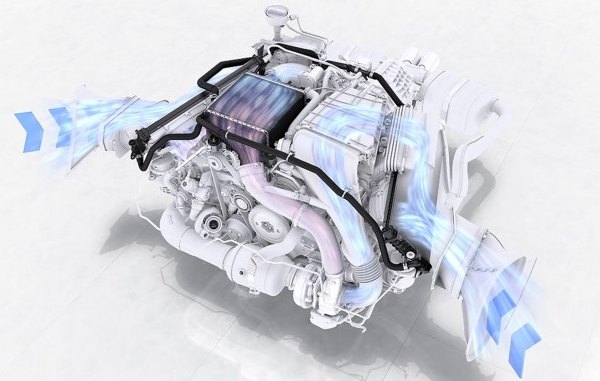 |
|
More
worrying, the longer exhaust manifolds result in more turbo lag...
|
|
Naturally, the 2.5-liter engine needs a larger turbo, which would have
worsened turbo lag further. Fortunately, it employs VTG (variable
turbine geometry) technology as seen on the 911 Turbo. Its vanes can be
adjusted according to rev to optimize turbine response and output. It’s
quite costly, so the base 2.0 engine uses a regular turbocharger. To
lessen the turbo lag shortcoming, both engines employ “dynamic boost”
function. When the driver lifts off throttle briefly, it halts ignition
and fuel injection but keeps the throttle butterfly open for up to 2
seconds so to keep the turbine spinning. Once the driver reapplies
throttle, boost can be built up quickly.
The engine shares most reciprocating parts with 911 (though the 2.5
employs larger pistons and valves) as well as direct injection and
iron-plasma-sprayed cylinder coating, though its compression ratio is
half a point lower at 9.5:1. VarioCam Plus serves both intake and
exhaust valves, which means the exhaust side gets variable valve lift
for the first time. Porsche did not explain why, but it is believed it
uses the low-lift setting at low rpm to reduce the effect of exhaust
gas drawing back to adjacent cylinder during intake stroke, again due
to the successive firing order of flat-4 layout. The flat-6 of 911 has
no such problems, so it doesn’t need VVL at exhaust side.
As seen in the picture above, the intercooler system mounted atop the
engine is quite cumbersome. While the 911 engine has 2 air-to-air
intercoolers mounted either sides of the engine and are cooled directly
by the side intakes, the single intercooler of 718 is a 2-stage
air-to-water system. The water circuit is cooled by the 2 side-mounted
radiators, then it cools the air circuit through a heat exchanger. It
has to be packaged tightly beside the intake manifolds.
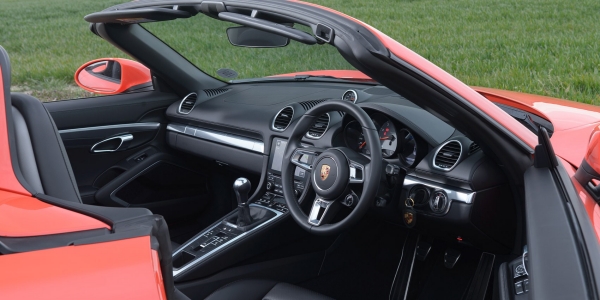
|
|
Engine
aside, it is still very much the same car as 981.
|
|
As seen, the new boxer-4 turbo has to overcome a lot of
technical difficulties not found on a flat-6 or inline-4. This
inevitably added some weight and costs. Is it worthwhile?
On the Road
Observing from outside, the 718 is not a big departure from 981. In
fact, engine aside it is still very much the same car as 981. The
styling is naturally evolved as in every iteration of Porsche. Is it
better looking? The answer is negative. A squarer nose and flatter body
panels around the tail means it loses a little bit aesthetic of the old
car. The Porsche name is now relocated to the black stripe under the
fixed rear spoiler. Unfortunately, this pushes up the rear deck thus
diminishes the sense of sleekness. Inside, the cabin is the same as
before except the semi-circular air vents, updated infotainment system
and a new driving mode switch on the steering wheel. In other words,
the driving position and visibility remain excellent, while build
quality has nothing to complain about. The power hood of Boxster
continues to offer good sealing and quick operation.
Press the start button, the 2.5-liter four-cylinder boxer fires up with
a subdued noise. It is rougher, bassier and much less dramatic than the
spine-tingling bark of the last naturally aspirated flat-six. Yes, it
sounds more Subaru Impreza than a Porsche. The disappointment grows
further once you engage 1st and ask the engine to deliver. Our
technical analysis is unfortunately correct. Below 2000 rpm, the engine
shows considerable turbo lag – not to the extent of 944 Turbo, of
course, but noticeably more than most modern turbocharged engines we
saw in the last couple of years. Give it 3000 rpm, however, the turbine
is fully spooled up and the throttle response is crisped. Yet the sound
quality doesn’t improve. As rev rises, the Subaru off-beat burbles
morph into a smooth drone, which is hardly engaging. Comparatively,
Jaguar F-Type V6 does a far better job in sound tuning.
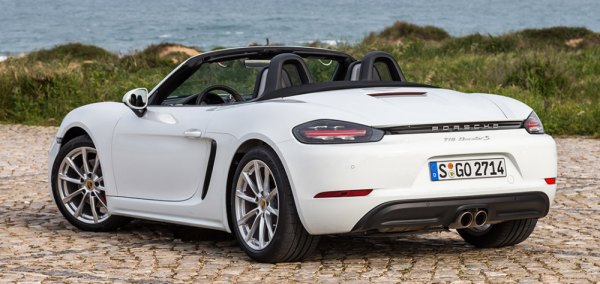
|
|
The
rougher, bassier exhaust note sounds more Subaru than Porsche...
|
|
In the mid-range, the turbo four feels a lot stronger than the old
flat-six. Undoubtedly, its real-world performance is elevated to a
higher league. However, as I always think, modern sports cars become
too powerful to be enjoyable on normal roads. The case of 718 is
especially obvious when you compare the driving experience with what we
remembered for its predecessor. Because the engine delivers its best in
the mid-range, you are not encouraged to rev it beyond 6500 rpm, even
though it is free to spin to 7500 rpm. Neither does the droney exhaust
note encourage you to do so. In the old car, you always wanted to
engage a lower gear, stretching the engine all the way to 7800 rpm to
get maximum power and aural rewards, or prod the throttle just to enjoy
its sharp response, wondering how fast its rev rises and falls. On the
new car, you spend half the effort yet returns faster acceleration. Any
more commitment would just overwhelm the road conditions and risk your
license. Losing a large part of the old car's emotion and character, it
is a more effective tool but not a better companion.
The base 2.0-liter engine has a smoother power delivery while its
exhaust is less gruff, but it is similarly characterless. That said, it
is now effectively faster than the old Boxster S, so with prices taken
into account (£42,000 vs £51,000) it is actually a better
option than the 2.5-liter.
As before, the car has 6-speed manual fitted as standard while 7-speed
PDK is optional. A taller final-drive ratio takes advantage of the
increased torque to allow fewer gearchanges in real-world usage. The
clutch and gearchange of the manual are just as light and accurate as
before, which is a pity as you are not going to engage them as often.

|
|
Unfortunately,
a great deal of emotion and sense of engagement is lost in the new
turbocharged flat-four...
|
|
The chassis is largely carried over from the last generation, but it
gets a 10 percent faster steering rack and stronger brakes from the
company’s vast parts pool. Springs, dampers and roll bars get slightly
stiffer together with a reinforced rear subframe. A sportier version of
PASM adaptive damping is available, which lowers ride height by 20 mm.
The rear suspension gets components from the Cayman GT4 to increase
lateral stability.
With these enhancements, the 718 feels more agile than ever. Its
balance is spot on, more incisive than 911 and matches the very best
Lotus Exige. Body control is remarkably tight. The Pirelli P-Zero tires
offer bags of grip and dependable traction. Its brakes are more than a
match for its performance. The electrical power steering is not as
tactile as the early Boxsters with hydraulic assistance, but it is
highly accurate, quick and well weighted. Other controls are just as
well tuned to give you a great sense of connection to the car. Push it
really hard and lift off mid-corner, the tail kicks out, but it is
progressive and easy to catch. This chassis forms a solid foundation
for the next Cayman GT4.
Most important, this car remains an everyday sports car, unlike Lotus
Exige or Alfa 4C. In all but the stiffest PASM modes, the suspension
leaves enough compliance for country roads. The body structure feels
rigid despite the open roof. The cabin sacrifices no creature comfort
for performance. It is one of the few sports cars that is truly usable
on daily basis yet being fast, fun to drive and reasonably affordable.
In fact, that is always the case of Boxster. Unfortunately, while the
718 is certainly faster, a great deal of emotion and sense of
engagement has been lost in the new turbocharged flat-four. Had we been
born in the new turbocharged era, we might be easier to appreciate it.
Once you have tasted the immense thrill of the old motor, there is no
way not to be disappointed with the new one, especially when it is not
quite as accomplished as its 911 brother. Let’s hope the next Spyder
and GT4 to keep the atmospheric flat-6.
|
Verdict:     |
Published
on 14
Jul 2016
|
All rights reserved.
|
|
718 Cayman
|
|
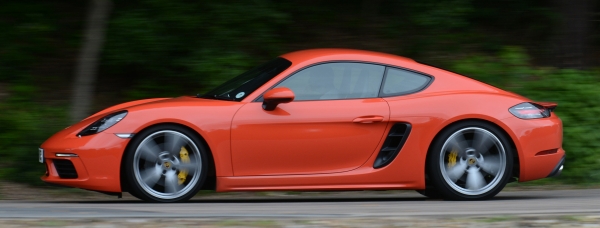 |
|
Cayman
is made cheaper than the equivalent Boxster for the first time.
|
|
As mentioned before, the
new Cayman is now officially the hardtop version of Boxster and both
are sold under the 718 moniker. It is also made cheaper than the
equivalent
Boxster for the first time, although the gap is less than 5 percent.
With the exception of roof, both cars are virtually identical,
including engine, steering and suspension tuning, so their difference
is smaller than ever. Porsche even quotes identical kerb weight and
performance figures for them.
In order not to disgrace the Boxster, Porsche does not reveal how much
torsional rigidity the Cayman gains this time around. However, you
might remember that Weissach said the last generation 981 Cayman was
nearly twice as rigid as 981 Boxster. Since the 718 keeps the chassis
largely unchanged, we assume the same can be said to the new car. That
said, on the road the Cayman shows little advantage to Boxster, because
the aluminum and high-strength-steel structure of Boxster is already
very stiff, without any creaks and scuttle shakes to speak of. Both
cars steer, ride and handle exceptionally good. You need a Lotus Exige
Sport 350 to beat them.
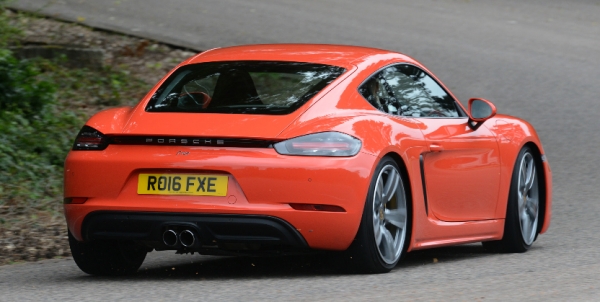 |
|
It
shares the same disappointment with its soft-top sibling: the
uninspiring engine.
|
|
Predictably, the 718 Cayman shares the same disappointment with its
soft-top sibling: the uninspiring engine. Losing 2 cylinders and
gaining a single turbocharger result in an uninspiring exhaust note and
a lazier tachometer needle. The turbine-smooth manner and razor-sharp
throttle response of the
old naturally aspirated motor are gone. Turbo lag is noticeable below
2800 rpm. Its 7500 rpm redline is
high for a turbocharged four-cylinder, but you are no longer encouraged
to access the very top end of the power band, blame to the thick
mid-range torque as well as the droney exhaust. The car is a lot faster
than before without question, but driving thrill actually takes a dip.
With a hard top, you hear less of the boring exhaust note, which is no
regret. But then again, having no regret to hear less the engine sound
is
exactly what makes the new car so regrettable!
That’s why the 718 Cayman loses the top rating like its Boxster
sibling. If you are not after open-air motoring, it should be a better
option than the Boxster, thanks to its slightly keener prices and
better looks – I always think a true Porsche should have a swoopy
fastback. It is still the most sensible sports cars in its price range,
but some of the magic of the old car has been lost.
|
Verdict:     |
Published
on 1
Dec 2017
|
All rights reserved.
|
|
718 GTS
|
|
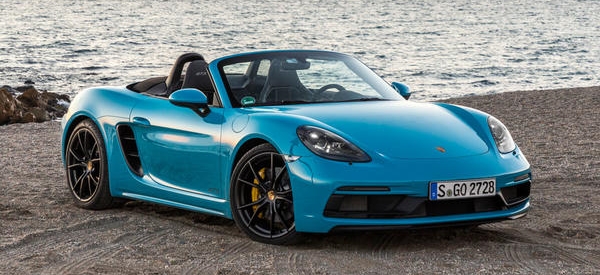
|
|
If
you are deaf, 718 GTS is still the perfect sports car...
|
|
I will try to write this
review as short as possible, because the GTS doesn’t deserve a lot of
words. Basically, it is the 718 S fitted with all the performance
options, i.e. PASM dampers (which also lowers ride height by 10mm),
20-inch wheels, mechanical LSD, Sport Chrono pack with launch control
(in case of PDK car) and sport exhaust. Then, tune its engine to
produce slightly more punch, and add 15 percent to the price tag. It
doesn’t even look prettier than the lesser cars. Its front bumper
remains too square, while the revised intakes look a bit aftermarket.
Porsche revised the intake duct and the VTG turbo on the 2.5-liter
boxer, lifting its boost pressure from 1.1 to 1.3 bar. Even so, its
output merely inches up by 15 ponies and 7 pound-foot – and that’s only
for the PDK car. With manual, peak torque is unchanged from the 718 S,
because the gearbox refuses to take more. As a result, the GTS is
barely quicker in PDK form. 0-60 and 0-100 mph are only one and
two-tenths quicker, respectively.
Can you feel that difference? Of course not! What you do feel is the
coarse, bassy exhaust drone gets even more annoying through the sport
exhaust. Every prod of throttle reminds you how disastrous Porsche has
turned the car from six to four cylinders. If you can live without
cupholders and bullet-proof reliability, buy Lotus Exige.
However, if you are deaf, 718 GTS is still the perfect sports car,
because its performance and chassis are both outstanding, not to
mention its everyday practicality. It is not necessarily better than a
718 S fitted with performance options, but it costs almost the same,
while the GTS badge makes you prouder.
|
Verdict:     |
Published
on 31
Jan 2020
|
All rights reserved.
|
|
718 Cayman GT4 and 718
Spyder
|
|
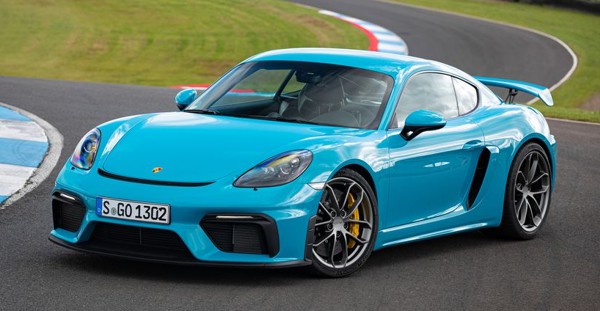
|
|
Thanks
to Taycan, Porsche is able to build more hardcore sports car again.
|
|
The new 718 Cayman GT4 and
718 Spyder are so familiar yet so different. Familiar is because
they do not deviate from the formula of the last cars: naturally
aspirated 6-cylinder engine, manual gearbox and a pure driving
pleasure. However, if you see them from the perspective of 718 series,
you will find them so different. Until the arrival of the duo, all 718
models are powered by 4-cylinder turbo engines. They lose the keen
sound and response of the flat-six engines traditionally associated
with the Boxster/Cayman. Had the 718 came right after 944 or 968, we
might be happy to accept a 4-cylinder turbo on an entry-level Porsche.
Once you have tasted the joy of flat-six power, there is no way to
return. The 718 series is very unfortunate that it falls victim to
stringent emission laws.
What drives Porsche to revive 6-cylinder naturally aspirated power on
the 718? The call of keen drivers? Might be, but I suspect it has more
to do with the arrival of Taycan. That zero-emission model helps
lowering the fleet emission of Porsche (which is added to the pool of
Volkswagen group), freeing Stuttgart from limiting the availability of
enthusiast models. As a result, the new GT4 and Spyder
can get an even larger engine – up from 3.8 to 4.0 liters like the 911
GT3. Moreover, they are no longer limited editions. Porsche will sell
as many as they can until they phase out in 2022. Good news to keen
drivers.

|
|
The
production-derived 4.0 engine is smooth, free-revving and most
important, makes proper noises for a Porsche.
|
|
The 4-liter engine might sound like a detuned version of the GT3
engine, but it is not. Despite sharing identical bore and stroke
dimensions, it is actually derived from the 9A2 Evo unit of the 911
Carrera. This means it is more road-friendly and less motorsport
inspired. Bore is enlarged from 91 to 102 mm, while stroke is
lengthened from 76.4 to 81.5 mm. It is served with high-pressure piezo
fuel injection (which allows up to 5 injections in each combustion
cycle) and particulate filters for cleaner emission, cylinder
deactivation system (which shuts down one of the cylinder banks at
lighter loads) for reduced fuel consumption and carbon footprint, while
a resonance-type variable intake manifold enables broader spread of
torque. Stripped of turbochargers, it is capable to rev to 8000 rpm, no
match for the 9000 rpm of GT3, but 500 rpm higher than the regular 911.
The way it delivers power is very different from its turbocharged
cousin, of course. Its peak power and torque are produced at 7600 rpm
and 5000-6800 rpm, respectively, giving the driver plenty of fun to
chase for revs and acoustic pleasure. Maximum output is 420hp, up 35hp
from the last GT4, but curiously, maximum torque is unchanged at 310
lbft.
Although revving the 4-liter boxer is not quite as thrilling as that of
the GT3, it is still a great pleasure to enjoy its free-revving manner,
quick throttle response and linear delivery. Compared with the old 3.8
engine, its exhaust note is a bit muffled by the particulate filters,
but the sound is still much richer than its 4-cylinder siblings. It
loves to rev, rewards you with a small boost in the mid-range, but the
best is reserved for the last 2000 rpm. It reminds us the good old days
when great sports car engines should encourage drivers to access the
very top end.
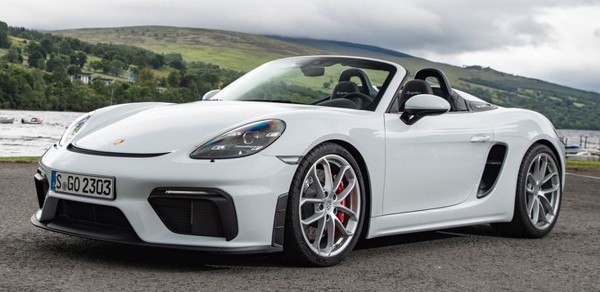
|
|
No
other sports cars on the market balance so well, so confidence
inspiring, no matter at any prices.
|
|
Lacking weight saving efforts to offset the heavier 718 chassis and
additional emission equipment, both the new GT4 and Spyder weigh 1420
kg, a substantial 80 kg and 105 kg more than their predecessors. If you
compare with the original 987 Cayman R and Boxster Spyder, the
differences are even more substantial. Consequently, the new cars are
only
marginally faster in straight line. They sprint to 60 and 100 mph in
4.2 and 9.0 seconds respectively, not particularly fast these days.
Part of the reason is the lack of PDK gearbox. As before, 6-speed
manual gearbox is the only option. Its gearshift quality is
flawless, being slick and short, while new automatic throttle blipping
helps smoothening downshift. On the downside, its ratios are too tall,
particularly the first 2 gears. This is perhaps
the car’s only obvious weakness.
However, the best of the car remains to be its handling. Changes to the
chassis are quite extensive. The front suspension comes straight from
the GT3. Ride height is lowered by 30mm, rubber bushings are replaced
by rigid ball joints, while inverted dampers are used at the rear to
enhance rigidity. The GT3-spec 380mm steel brakes might be oversized
for the smaller car, yet you may opt for ceramics brakes. The front and
rear
wheels are shod with 245/35ZR20 and 295/30ZR20 Michelin PS Cup 2
rubbers. Meanwhile, aerodynamics is improved. The GT4 gains 50
percent more downforce, thanks in part to the big rear spoiler and a
functional diffuser, so that now it generates 122 kg at top speed. The
Spyder keeps a cleaner rear end, but it gets a retractable spoiler to
achieve a slight positive downforce. In addition to the increased
power,
the GT4 can lap Nurburgring at 7:30, 12 seconds less than the old car.
Spyder won’t be much slower, because it is practically the same as the
coupe, bar inferior aerodynamics and a slight loss of chassis rigidity.

|
|
The
Spyder is almost as good as the GT4, especially on road.
|
|
The old GT4 was already known for first class handling. The new car
carries on this merit. It combines exceptional roadholding, body
control and balance. The steering is impossibly feelsome and intuitive
for an electrical rack. Turn-in is pin-sharp. In corners, it rotates at
your will, breaks out progressively and settles at the knife edge
easily. The old car’s slight nervousness at the very limit has all
gone. No other sports cars on the market balance so well, so confidence
inspiring, no matter at any prices. If not the self-imposed product
hierarchy, this chassis could have accepted another 100 horsepower.
The Spyder is almost as good. Drive hard on a track you might sense a
slight loss of rigidity and downforce, but on the road it doesn’t make
any differences. The lack of roof means in the Spyder you can hear more
of the engine noise, which is welcomed. Both cars ride smoother than
before, so they are perfectly acceptable for everyday driving. At
£75,000 and £73,000 respectively, the GT4 and Spyder are
considerably more expensive than the old cars, but still a bargain
considering the driving excitement they offer. If you want an
alternative offering nearly as much fun, you need to look down to
Alpine A110 or up to McLaren 600LT. The Porsche duo occupies the sweet
spot of the market. Neither too slow nor too fast, neither too cheap
nor too pricey, and immense fun is guaranteed. That is also what makes
Porsche so famous over the decades.
|
Verdict:      |
Published
on 29
Feb 2020
|
All rights reserved.
|
|
718 GTS 4.0
|
|
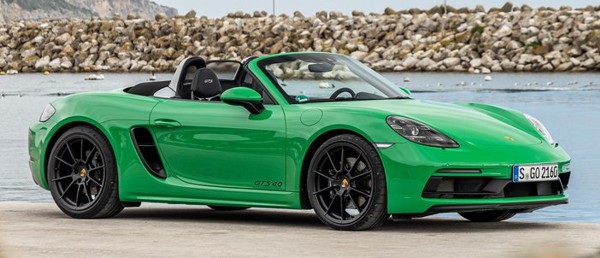
|
|
The
last piece of puzzle is finally filled: a great six-cylinder engine.
|
|
The last 718 GTS lived only
2 years, unusually brief for a production Porsche. Motoring journalists
are quite harsh on the aural experience of its four-cylinder boxer
turbo. They might forgive that on a base 718, less so the S model, but
when it
comes to a range-topping GTS costing north of £60K, its coarse
exhaust note is simply intolerable. No matter how sweet its chassis is,
it is hard to love. No wonder Porsche decides to cut its lifespan short
and implement plan B: the return of 6-cylinder power, Voilà !
The new 718 GTS, dubbed 4.0 to distinguish from its 2.5-liter
predecessor, is not difficult to develop. Its chassis is virtually
unchanged because the naturally aspirated 6-cyliner engine is not that
much heavier than the 4-cylinder unit with the associated turbo and
cooling system. The flat-six is not a new development either, as it
comes straight from the recent GT4 / Spyder. You might remember,
despite displacing the same 3996 c.c., that motor is not derived from
the motorsport unit serving the 911 GT3, but it is enlarged from the
9A2 unit serving the production 911 Carrera and Carrera S. Porsche has
already done enough work to lift its efficiency, giving it
high-pressure piezo injection, cylinder deactivation, resonance
variable intake manifolds and a particulate filter so that it is
future-proofed. If not destined to the new GTS as well, I suppose
Porsche would not have invested so much.
The 4.0 motor is physically the same as the one serving the GT4 and
Spyder, just has its ECU remapped to limit its high-end delivery. This
means fuel is cut off at 7800 rpm instead of 8000. Maximum output loses
20 horsepower to 400, and it is released at 7000 rpm, 600 lower than
that engine. Compared with the last GTS 2.5 turbo, it gains 35 horses,
but maximum torque stays at 310 lbft, and it arrives much later
at 5000-6500 rpm. No wonder the quoted performance is just marginally
improved.
The GTS also shares its 6-speed manual gearbox with the GT4 and Spyder,
although the throw of its shifter is made longer for ease of use. No
PDK is offered now, but will arrive later this year.
On the road, the new motor is far more exciting. Smoother, more
rev-hungry, way more responsive to throttle and, most important, sounds
good. The howls towards 7800 rpm is addictive. There is less mid-range
torque for sure, but the new-found linearity and enthusiasm for rev are
far more encouraging. From 5000 rpm onward it punches harder and
harder, rewards you with angrier sound and goes mad at the last 1000
rpm. The manual gearbox enhances the experience with its sweet
gearshift and a well-modulated clutch. The GTS 4.0 returns to form not
because of quantity but quality.
What stops the GTS from matching the GT4 and Spyder is the chassis. As
an everyday road car, it lacks the GT3-derived front axle, ball-joint
suspensions, inverted dampers and the larger brakes of its more
hardcore siblings. It lacks the GT4’s big wing and diffusers, too, and
it
uses narrower and non-Cup tires, so cornering prowess, precision and
turn-in are all less remarkable. That said, as a road car the 718
always shine in ride and handling, especially the GTS has adaptive
dampers and active engine mounts fitted standard. The lightweight
Alpine is still more agile and involving to drive, but the 718 GTS is
arguably more rounded, especially now it gets one of the best motors in
the industry.
|
Verdict:      |
Published
on 25
Oct 2022
|
All rights reserved.
|
|
718 Cayman GT4 RS
|
|
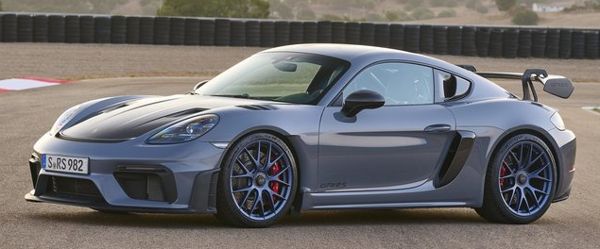
|
|
The
GT department takes the last chance to realize something they - and us
- have been wishing for many years.
|
|
Porsche made no secret that
the next generation 718 Cayman and Boxster will be transformed to a
pure electric sports car. It will be faster, of course, but it will
lose the sound, the enthusiasm for revs and the thrills associated with
every Porsche sports car since the very beginning, unfortunately. To
many petrolheads, that will be the end of the world. However, to
Andreas Preuninger, the head of Porsche’s GT department, it means the
last chance to create something he wanted for years, but has always
been refused due to fears that such a car could threaten the mighty
status of 911. By installing the GT3’s 9000 rpm motor into the lighter
and better balanced Cayman chassis, it must be a dream to drive.
Probably better than the 911 GT3 even. So why is he given the
greenlight this time? There is no official answer, but not difficult to
understand if you consider the ultimate version of 718 will be
shortlived and strictly a one-off, because its much heavier and
electric-powered successor will not be fit for the same purpose. In
other words, it will do little harm to the 911 GT3.
To keep harms to the minimum, the ultimate Cayman is named not GT3 but
GT4 RS, suggesting a less exotic but more track-oriented character than
the GT3. That is misleading, of course, as the GT4 RS is every bit as
exotic as the GT3. The motorsport-derived 4.0-liter flat-six is
transplanted straight from the GT3. Still revs to the magical 9000 rpm,
gifted with incredibly sharp throttle response, it produces 500
horsepower at 8400 rpm and 332 pound-foot of torque at 6750 rpm. Few
road-going engines could be as willing and thrilling as this one. You
might ask why it loses 10 horsepower and 15 pound-foot from the GT3
engine. The answer is the mid-engined machine requires longer exhaust
pipes, and has them routed across the rear axle increases
back-pressure. But in the real world, I suppose you won’t be able to
tell the difference, especially when this one produces a deafening
soundtrack at full throttle. Yes, it is louder than even the GT3, not
least because its cockpit is nearly uninsulated, but the new engine
intakes opened at the rear quarter windows pump induction noise
straight into the cockpit (the usual side intakes are left to purely
engine cooling). From the driver seat, it is very possibly the loudest
road car you can buy today, overwhelming any Lamborghinis, Ferraris or
McLarens.

|
|
A
Cayman with 500 hp, 9000 rpm engine has to be great, especially with so
much noise.
|
|
Then comes the mandatory PDK gearbox. While the GT4 and lesser 718s are
criticized for having too long gearing, the GT4 RS gets a set of closer
ratios and shorter final drive from the last 991.2 GT3 RS. Top speed is
now reached at 7th, while other ratios are evenly spread. Not only
easier to find the right gear for cornering, engine response and
acceleration are significantly improved.
When equipped with the super-sticky Michelin Pilot Sport Cup 2 R
rubbers (Cup 2 is recommended for road use), the GT4 RS is capable to
hit 60 mph from rest in merely 3.2 seconds, 100 mph in 7.1 seconds and
124 mph in 10.9 seconds, virtually the same as the 911 GT3. Top speed
is equally impressive at 196 mph. There are faster cars, of course, but
remember, this kind of performance comes from a naturally aspirated
six-cylinder engine.
The racing-inspired aerodynamic package includes a larger front
splitter, louvered vents on front fenders, a pair of NACA ducts on
front bonnet (for cooling the brakes) and a larger rear wing suspended
by swan-necked brackets. The latter’s smooth underside improves
downforce. The front splitter and rear wing are manually adjustable. At
maximum angle, the aero generates 100 kg of downforce at 124 mph, or 25
percent more than that of the regular GT4. It fails to match the GT3’s
385 kg though.
At 1415 kg in standard specifications, the GT4 RS is 35 kg lighter than
the equivalent GT4, or 20 kg less than the 911 GT3. Weight reduction is
achieved with carbon-fiber bonnet, front fenders, rear wing and racing
buckets, lighter rear glass screen, reduced sound insulation,
lightweight carpets, fabric door pulls and single-lock alloy wheels.
Optional Weissach package adds titanium exhaust and roll cage, but PCCB
brakes and magnesium wheels (which cut 10 kg) are very expensive
options. The standard brakes are composites (steel discs with aluminum
bells). Compared with GT4, the front brakes have been enlarged from 380
to 408 mm, clamped with 6-piston calipers.
The suspension of GT4 already got 30 mm lower than the base 718 and
rigid ball joints for some attachment points, but the RS spec.
suspension turns all attachment points to ball joints and adds helper
springs front and rear for even higher precision. Its ride height,
camber, track width and anti-roll bars are all adjustable for track
use. Springs are 40-66 percent stiffer than those of the GT4. PASM
adaptive dampers are standard. Limited-slip differential remains to be
a mechanical type, as there is no space to fit an active differential,
unlike the 911 GT3. Torque vectoring is still managed by brakes.
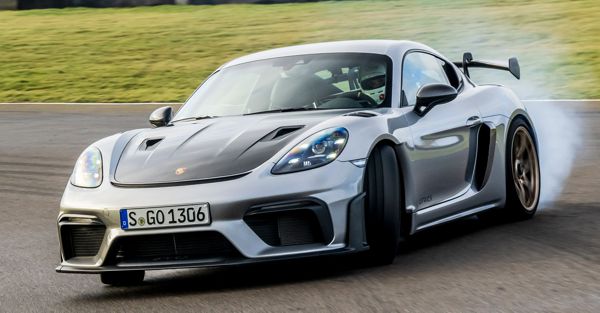
|
|
A
chassis balance so outstanding that neither trailing throttle nor
sudden braking could shake its mid-corner stability.
|
|
Overall speaking, this car has a power-to-weight ratio matching the
mighty GT3, but loses to its senior brother in terms of downforce,
traction and grip. The GT3’s active differential and more rear-biased
weight distribution give it an advantage in traction. Its
double-wishbone and multi-link suspensions are also better than the
718’s all-strut suspensions for keeping the wheels perpendicular to the
road and maximize tire contact patches. Moreover, it wears 10 mm wider
front and 20 mm wider rear tires than the GT4 RS. These explains why
the latter trails its senior brother by 9 seconds in Nürburgring,
lapping the old 20.6km course in 7:04.5. Still, it is a massive 23.6
seconds quicker than the lesser GT4.
However, lap time is not everything. The GT4 RS might not be as grippy
or as swiss-watch accurate to corner as the GT3, but it feels better
balanced and more agile. Although it also rides very hard, it feels
narrower and easier to maneuver on a narrow country road. Its steering
is beautifully weighted and honest about the grip level up front. It is
willing to change direction and has enough power to oversteer, although
it takes some serious effort to slide on a dry road. When it breaks
away, it is less forgiving than the GT3 due to the lack of active diff.
It isn’t an inherent tire-burner like BMW M-cars or big AMGs, but a
more serious track weapon. Razor sharp turn-in, rock steady body
control, jaw-dropping braking and a chassis balance so outstanding that
neither trailing throttle nor sudden braking could shake its mid-corner
stability. Supported with sharp throttle response, linear power
delivery and quick gearshift, it is immense fun to exploit the deep
reserves of the GT4 RS on track. Not as quick as the GT3, but more fun
to have.
Starting at £108,000, this is the first entry-level Porsche
sports car associated with a 6-figure price tag, though it is
£20K.less than a new GT3. Not many cars can rival it for the same
or less money. Lotus no longer builds comparable road and track cars. A
new Corvette Z06 might be as quick on straight, but lacks the track
appeal of the Porsche. The new BMW M4 CSL is even more expensive
without guaranteeing more thrills. The GT4 RS delivers everything we
suspected Porsche could achieve with it for so many years. It will be
shortlived, but definitely be remembered fondly.
|
Verdict:      |
Published
on 10
Aug 2023
|
All rights reserved.
|
|
718 Spyder RS
|
|

|
|
Porsche
saves the best for the last.
|
|
We thought Cayman GT4 RS to
be the ultimate combustion mid-engined Porsche, but it turns out to be
Spyder RS.
Priced at the same £123,000 as the GT4 RS – which has
dramatically increased from the debut price of £108K – the Spyder
RS is practically the open-top version of the latter. It shares the
same “GT3” engine, i.e. a 4.0-liter flat-six good for 500 horsepower
and 9000 rpm redline, the same 7-speed PDK transmission, the same
ball-jointed suspension with adjustable ride height, camber, track
width and anti-roll bars, the same brakes, the same wheels and tires,
the same carbon-fiber bonnet and fenders. However, the Spyder RS lacks
the aggressive aero of its coupe sibling. Gone is the huge rear wing as
well as the adjustable vanes in the front underbody. The front splitter
is also shortened to keep the same aero balance. Obviously, it is not
quite as track-oriented as the GT4 RS.
In fact, Porsche deliberately makes it more friendly for road use. In
particular, the front and rear suspension springs have been softened by
55 and 43 percent, respectively, while dampers have been retuned
accordingly. Ride height is set 5 mm higher than the coupe. On the
road, it is really more forgiving. While the GT4 RS rides so stiff that
only hardcore drivers will appreciate, the Spyder RS absorbs bumps and
broken surfaces much better. Traction is also improved, as it is no
longer easily deflected by sharp bumps. Not just more comfortable to
cruise, it is actually easier and more confidence inspiring to drive
quickly on back roads.
Surprisingly, despite the lack tin top, cruising refinement on highway
is also improved, because engine noise no longer resonates in the
cabin. You still get the delicious induction note from the intakes
located at the top of rear fenders, just behind your head, but noise
level is reduced a little, which is good news because the GT4 RS is way
too loud for everyday driving.
Thanks to a bespoke 2-piece manual fabric roof, which is 8 kg lighter
than even the simple stuff used by the regular Spyder, this car is
actually a tad lighter than its coupe sibling. Porsche quotes exactly
the same performance figures bar top speed, which is 5 mph down. With
softer suspension and reduced downforce, the Spyder RS is not as quick
on track, of course, but it is a better car on most roads. Better
noise, better comfort and better manner, with no reduction in driving
excitement.
|
Verdict:      |
|